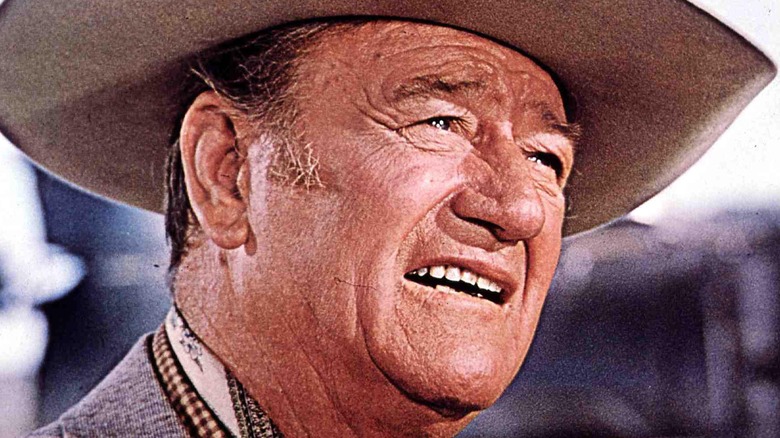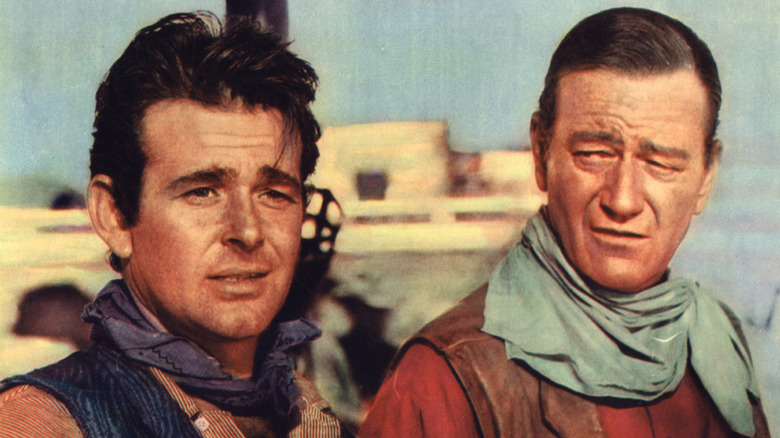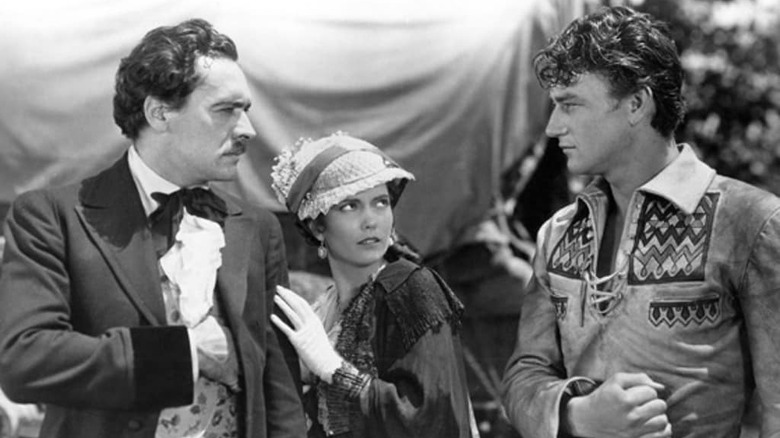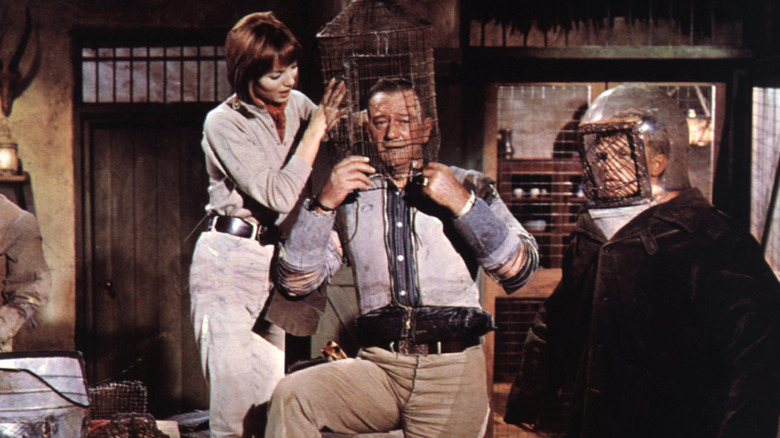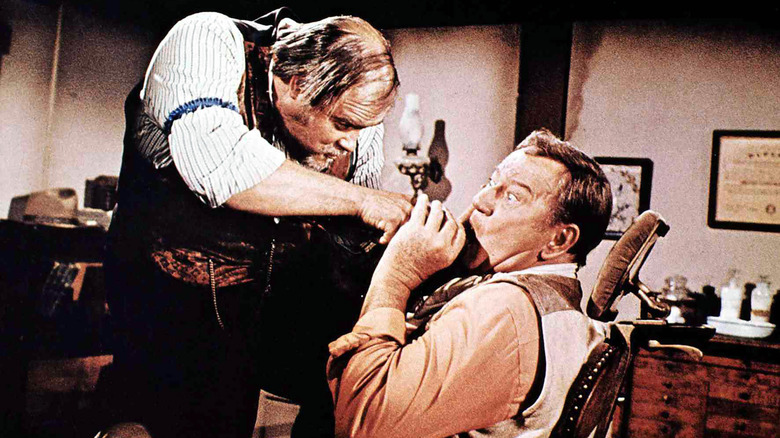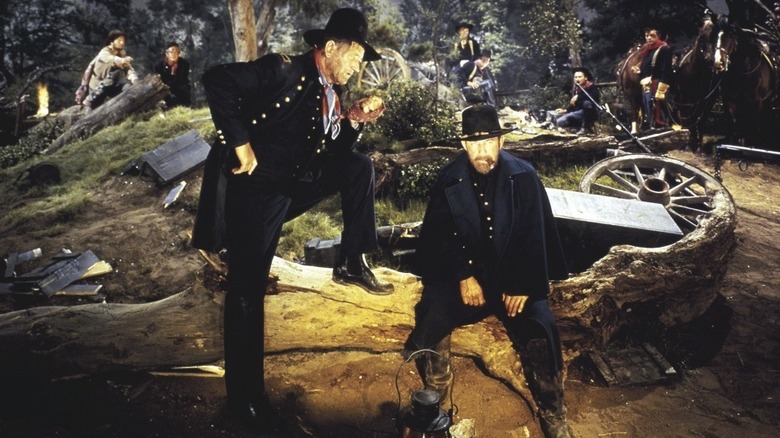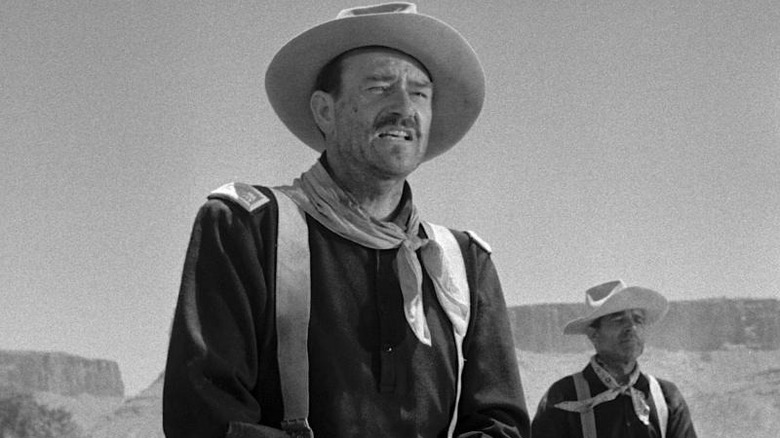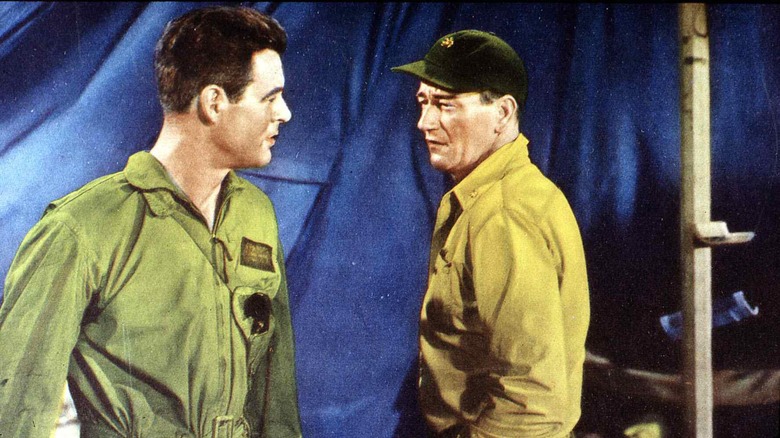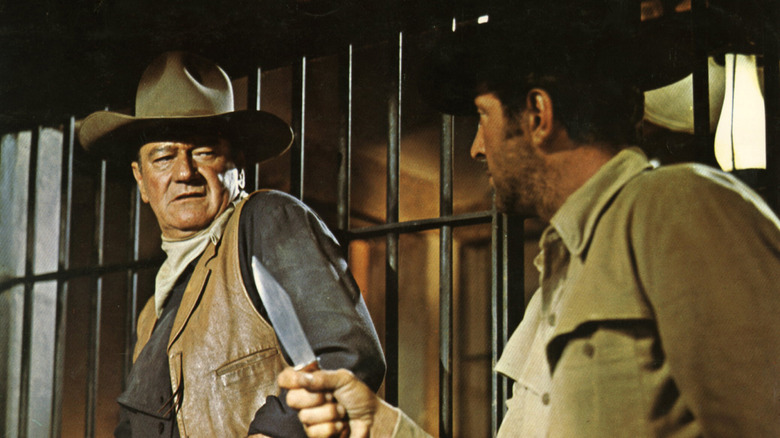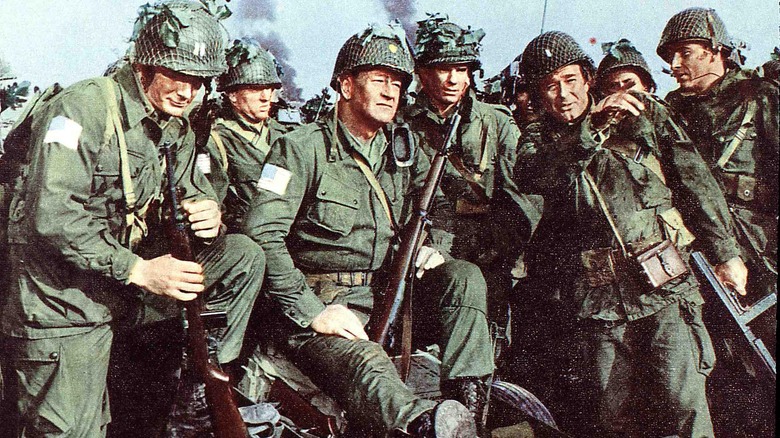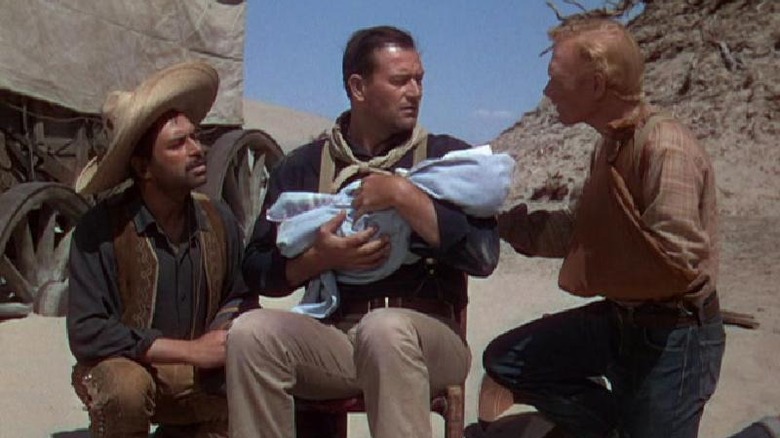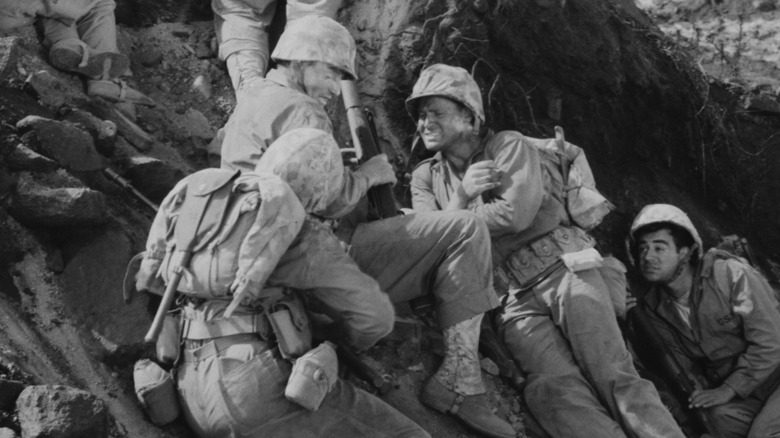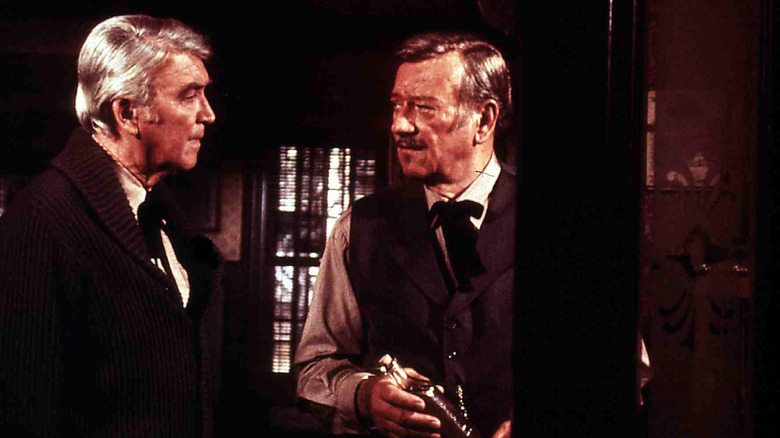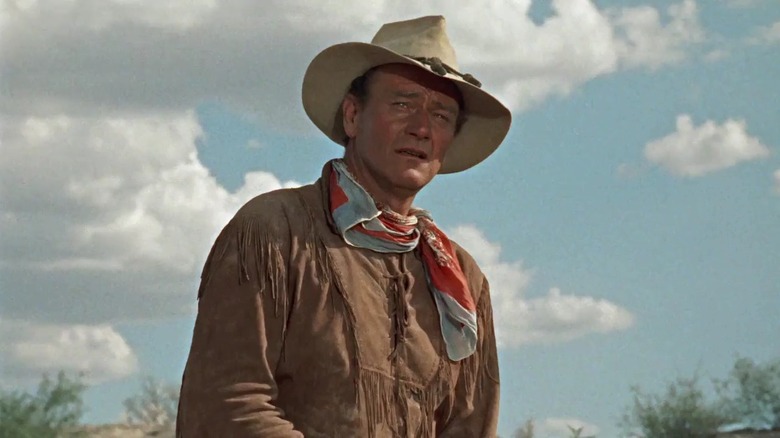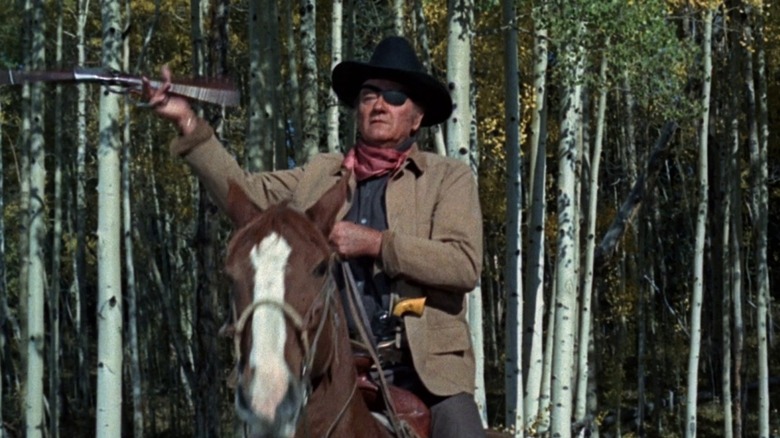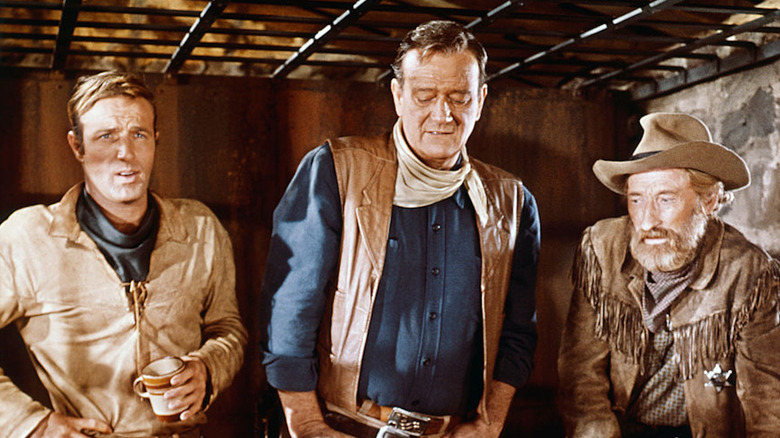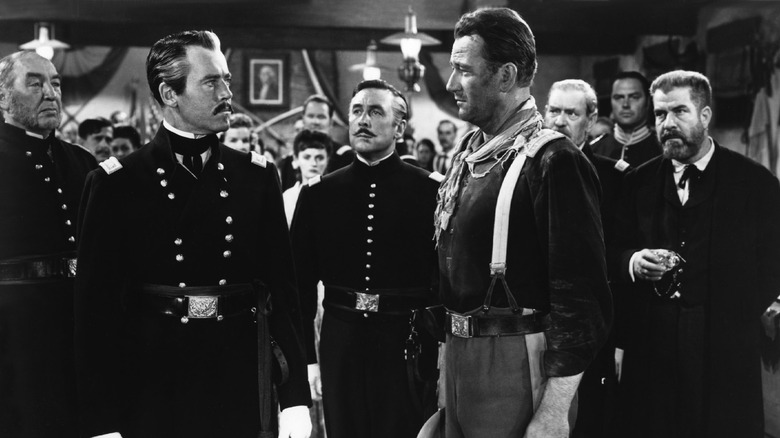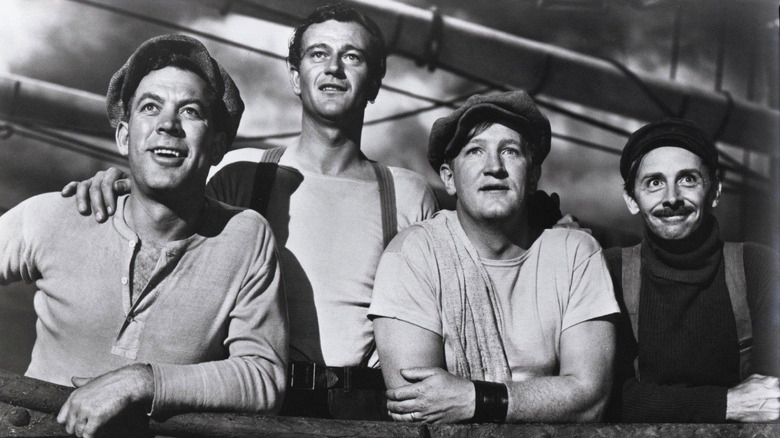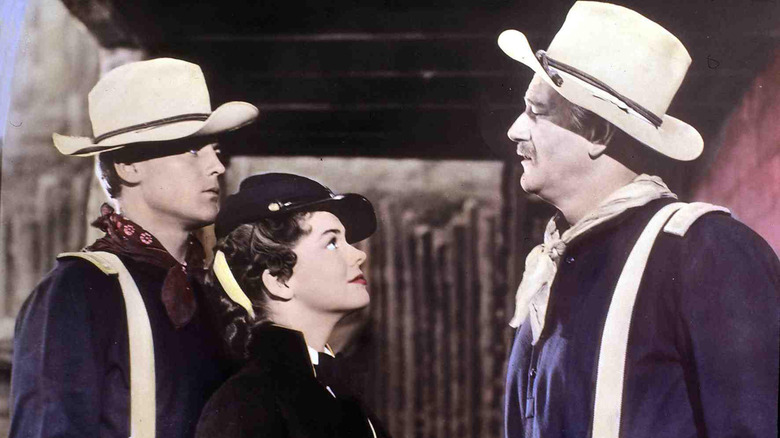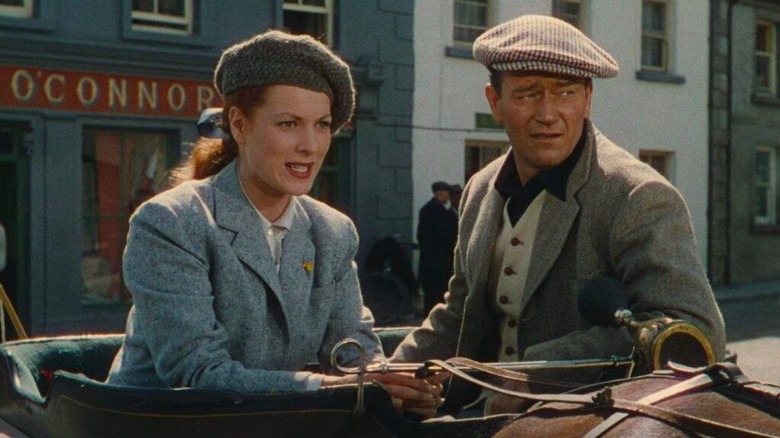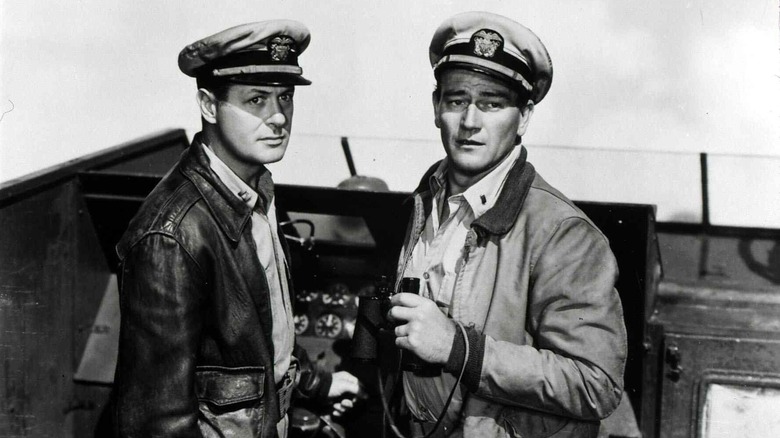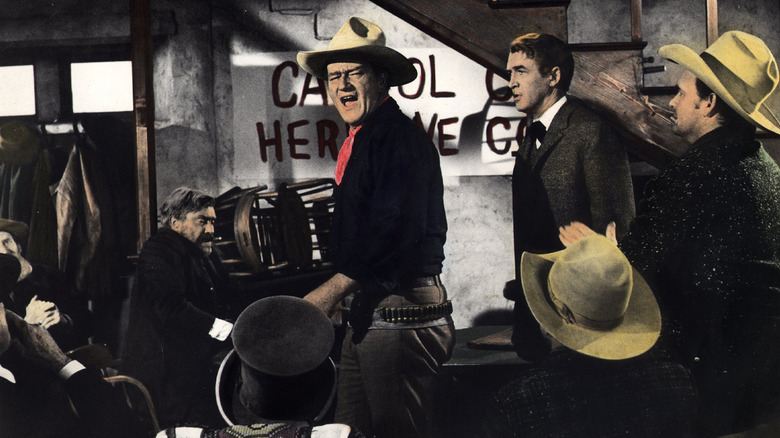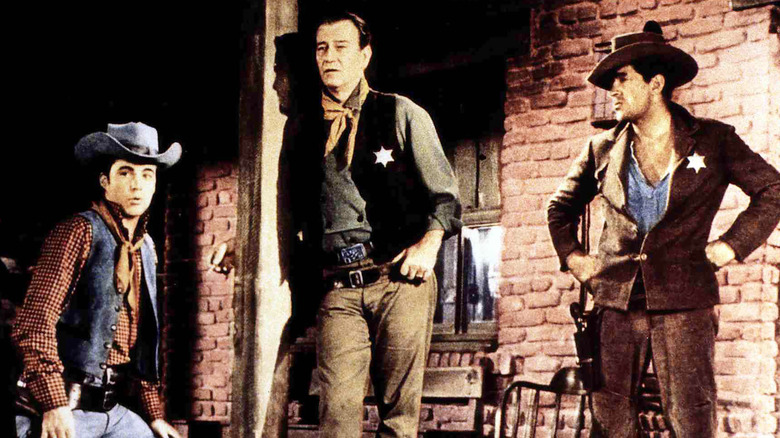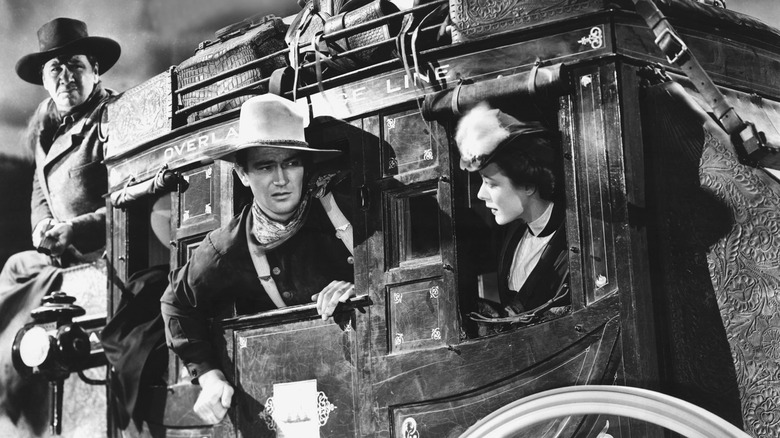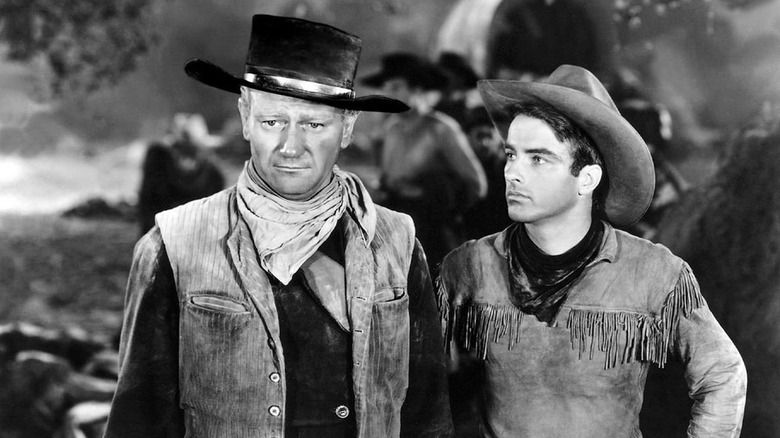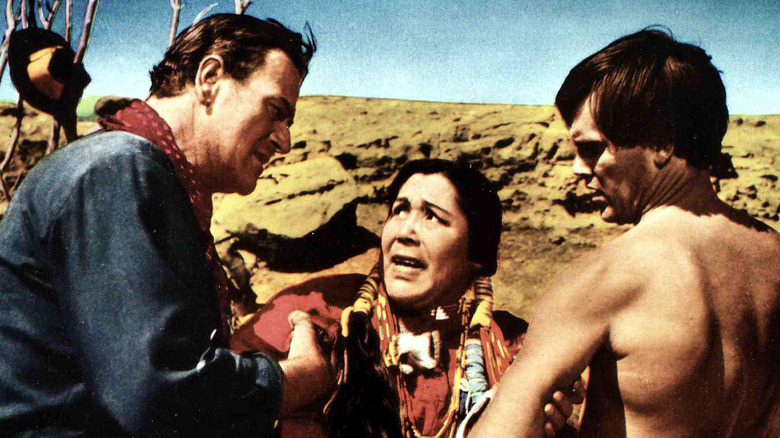25 Best John Wayne Movies Of All Time
The Duke. Just the invocation of that nickname creates an image in an audience's mind of a certain masculine ideal created by John Wayne. Be it in Westerns or in war films, Wayne was America's favorite strong, laconic screen hero for nearly four decades. Yet his persona in popular culture doesn't begin to encompass the range of his acting abilities.
After changing his name from Marion Morrison, Wayne got his start as a background player before working his way up to leading man in grade-Z Westerns produced by Poverty Row Studios. Yet it was during that time that he caught the eye of director John Ford, who cast him as the lead in his landmark Western "Stagecoach" (1939). Ford turned out to be Wayne's most important collaborator, shaping and subverting his screen image in films such as "She Wore a Yellow Ribbon" (1949), "The Quiet Man" (1952), "The Searchers" (1952), and "The Man Who Shot Liberty Valance" (1962).
Although he appeared in over 160 films, Wayne only earned two Oscar nominations for Best Actor: the first for "Sands of Iwo Jima" (1949), and the second for "True Grit" (1969), which he won. He also competed in the Best Picture race for his passion project, "The Alamo" (1960), which he also directed.
With so many films to choose from, it can be hard to narrow down the Duke's filmography to a best-of list, but let's try. Here's a look back at John Wayne's 25 best movies, ranked from least to finest.
25. The Comancheros (1961)
Although uncredited, John Wayne took over directing duties on "The Comancheros" when original helmer Michael Curtiz ("Casablanca") became terminally ill with cancer. (Wayne also directed the critically-derided war epic "The Alamo" the previous year, so he wasn't without some form of filmmaking experience.)
Despite the production troubles, the result is an entertaining yarn about a Texas Ranger (Wayne) who apprehends a gambler (Stuart Whitman) wanted for the murder of a Louisiana judge's son. The odd couple soon set their differences aside to take down the "Comancheros," a gang of army merchants smuggling arms and alcohol to Comanche Indians.
24. The Big Trail (1930)
Although creaky by today's standards, Raoul Walsh's epic Western "The Big Trail" deserves special consideration for giving John Wayne his first starring role after a series of background roles and bit parts. Shot in an early widescreen format known as 70mm Grandeur, it's the story of a fur trapper (Wayne) leading a group of settlers from the Mississippi River to a new life out west.
Although the film's failure at the box office (via Marilyn Moss's "Raoul Walsh: The True Adventures of Hollywood's Legendary Director") forced the Duke into starring roles in grade-Z westerns for much of the 1930s, "The Big Trail" does hint at the stardom he would achieve just nine years later in John Ford's "Stagecoach."
23. Hatari! (1962)
Shot on location in what's now known as Tanzania, "Hatari!" is a typical Howard Hawks tale of brave men performing a dangerous job, with John Wayne once again at the center. It's the story of a group of wild animal trappers in Africa who capture wild beasts to sell to museums. Wayne is the group's leader, whose own wild heart is tamed by the arrival of an Italian wildlife photographer (Elsa Martinelli).
The film's rich Technicolor cinematography, which captures the rough and tumble majesty of its terrain as beautifully as any nature documentary, earned an Oscar nomination for Russell Harlan.
22. Rio Lobo (1970)
The final film directed by frequent Wayne collaborator Howard Hawks, "Rio Lobo" is part of an unofficial trilogy the two made that includes "Rio Bravo" and "El Dorado." In each film, the Duke plays a noble lawman fighting back against a gang of outlaws laying siege to a small town.
This time, he plays a former Civil War colonel hunting down a pair of traitors who helped the Confederates defeat his unit, killing his best friend in the process. His search leads him to the town of Rio Lobo, where all hell breaks loose in classic Wayne fashion.
21. How the West Was Won (1962)
The sprawling, all-star epic "How the West Was Won" is mostly remembered today for its technical innovations rather than its plot or characters (it was the first narrative film shot in the now-defunct three-camera widescreen process known as Cinerama).
It's divided into five segments and an epilogue, each detailing a part of America's western expansion as seen through the eyes of one multi-generational family. Wayne appears as General William Tecumseh Sherman in the section about the Civil War, directed by the Duke's favorite filmmaker, John Ford (the other segments were helmed by Henry Hathaway and George Marshall).
20. Rio Grande (1950)
The third installment in John Wayne and John Ford's unofficial cavalry trilogy (preceded by "Fort Apache" and "She Wore a Yellow Ribbon"), "Rio Grande" is yet another nostalgic rumination on frontier life from the director and star.
Wayne plays Lt. Col. Kirby Yorke, who's tasked with protecting a cavalry regiment against invading Apaches. As if that weren't enough, he's also having problems with the arrival of his estranged wife and son, a reckless new recruit at the outpost. Like the previous cavalry films, this one offers Wayne a gentler change of pace from his usual macho roles.
19. Flying Leathernecks (1951)
When he wasn't riding in a saddle, Wayne was suiting up for duty as America's favorite war movie star (despite never having served, unlike many actors and filmmakers — including pal John Ford — who joined the Army during World War II).
In Nicholas Ray's rousing military drama "Flying Leathernecks," he plays Major Dan Kirby, the newly arrived commanding officer to a squadron of Marine pilots known as The Wildcats. The tough-as-nails Major Kirby clashes with the more easygoing Captain Griffin (Robert Ryan) over the squadron's lack of discipline as he prepares them for the Battle of Guadalcanal.
18. The Sons of Katie Elder (1965)
Production on Henry Hathaway's "The Sons of Katie Elder" was temporarily halted as Wayne underwent surgery for lung cancer (he would die of stomach cancer in 1979). Yet you'd never know the Duke was ailing from his performance, which is filled with his typical grit and swagger.
He's reunited with his "Rio Bravo" costar Dean Martin for the story of four brothers (rounded out by Michael Anderson Jr. and Earl Holliman) who return home for their mother's funeral. While there, they discover their father has been murdered after gambling away the family ranch, which they pledge to win back to honor their mother's memory.
17. The Longest Day (1962)
Featuring an all-star cast and mounted on a giant scale, "The Longest Day" recounts the events of D-Day from the points-of-view of both the Allies and the Germans.
So large was the ambition of Darryl F. Zanuck's production that it took three different directors to bring it to the screen (Ken Annakin handled the British and French segments, Andrew Marton helmed the American ones, and Bernhard Wicki shot the German sections). He also employed a large international cast to distinguish each role, including Wayne as Lt. Col. Benjamin H. Vandervoot, a real life officer who was present at D-Day.
16. 3 Godfathers (1948)
More lighthearted and cheerful than most of Wayne's collaborations with director John Ford, "3 Godfathers" finds the Duke adding a more tender side to his usually gruff exterior.
It's a retelling of the Three Wise Men story set in the Wild West, with Wayne, Pedro Armenderiz, and Harry Carey Jr. playing a trio of bank robbers on the run from a dogged sheriff (Ward Bond) after pulling off a heist. While traipsing through the desert, they encounter a woman (Mildred Natwick) dying in childbirth, and the three vow to safely transport her newborn baby to the town of New Jerusalem.
15. Sands of Iwo Jima (1949)
Despite starring in dozens of classic films, Wayne only earned two Oscar nominations for Best Actor, the first of which came for this stirring war epic (more on the second later). Helmed by Old Hollywood veteran Allan Dwan, it's one of many WWII dramas that hit theaters in the years during and after the war, many of which starred the Duke.
Here he plays Sgt. John M. Stryker, a tough-as-nails Marine sergeant who puts his men through the emotional ringer. Although they question his methods, they learn the reasoning behind them once they're thrown into the ferocious Battle of Iwo Jima.
14. The Shootist (1976)
After 50 years in front of the camera, Wayne bid adieu to movie audiences with one final role in the genre that made him an icon. You couldn't ask for a better sendoff — or a more poignant one — as Wayne would die of cancer just three years later.
In Don Siegel's elegiac "The Shootist," he plays dying gunman J.B. Books, who wants to spend his final days in peace and quiet. He finds solace in the home of a widow (Lauren Bacall) and her son (Ron Howard), but the sins of his past keep catching up with him in this low-key yet compelling screen farewell.
13. Hondo (1953)
With films like "Hondo," the Duke began to sand off some of the rough edges from his macho image, showing off a more tender side to his screen persona. John Farrow's Western classic casts Wayne as the titular Hondo, a bitter cavalry scout who arrives at the ranch of a homesteader's wife (Geraldine Page) and her son (Lee Aaker).
After he learns that the man of the house has abandoned them following an Apache attack, Hondo offers to escort the family back to civilization. But when they refuse to leave, he agrees to stay on, becoming a surrogate father figure. According to numerous reports, John Ford directed at least two battle scenes at the end of the film, although the extent of his involvement has been disputed as well.
12. True Grit (1969)
It only took about 40 years and more than 100 films, but Wayne finally won his long overdue Best Actor Oscar for this rousing Western yarn. At a time when directors like Sam Peckinpah and Sergio Leone were taking the genre in bloody new directions, "True Grit" is a real throwback, with Old Hollywood veteran Henry Hathaway crafting an old-fashioned entertainment with the Duke at its center.
He plays Rooster Cogburn, a drunken, one-eyed U.S. Marshal who's hired by a young girl (Kim Darby) to hunt down her father's killers. The film was so popular that Wayne reprised the role in a sequel, 1975's "Rooster Cogburn." Even the critically acclaimed Coen Brothers remake starring Jeff Bridges as Cogburn couldn't diminish the luster of Wayne's original.
11. El Dorado (1966)
The second in an unofficial trilogy of Westerns starring Wayne and directed by Howard Hawks (the first being "Rio Bravo" and the third being "Rio Lobo"), "El Dorado" finds the Duke saddling up with fellow Old Hollywood legend Robert Mitchum and New Hollywood rising star James Caan.
It stars Wayne as a hired gun who teams up with a drunken sheriff (Mitchum) and a young gambler (Caan) to help a group of homesteaders against an evil landowner (Ed Asner). Though little more than a "Rio Bravo" retread (with the same screenwriter, Leigh Brackett, no less), it's always a hoot watching Wayne protect innocent folks from the unscrupulous.
10. Fort Apache (1948)
The first installment of Wayne and director John Ford's cavalry trilogy (followed by "She Wore a Yellow Ribbon" and "Rio Grande"), "Fort Apache" finds the Duke playing the stoic hero to Henry Fonda's showy villain. It also showcases a more sympathetic side to his screen persona, as the character (and the film as a whole) takes a more humane view towards Native Americans than most Westerns at the time.
Wayne plays Captain Kirby York, a Civil War veteran who clashes with the newly appointed head of his regiment at Fort Apache, Lt. Col. Owen Thursday (Fonda). Thursday's racism towards the Native Americans causes him to push for violent conflict, putting him at odds with the more compassionate York.
9. The Long Voyage Home (1940)
Fresh off his star-making turn in John Ford's landmark Western "Stagecoach," Wayne was already starting to stretch his screen persona with another Ford collaboration. Released the year after "Stagecoach," "The Long Voyage Home" takes him out of the Old West and places him on the high seas.
Adapted from a collection of Eugene O'Neill plays, it's a moody, sensitive tale of sailors aboard a merchant steamer in the days before World War II. Wayne plays Ole Olsen, a sweet, big-hearted Swede who leaves his farm behind for adventures abroad. Nominated for six Oscars (including Best Picture), the film is early evidence the Duke was suited for roles that didn't include a saddle.
8. She Wore a Yellow Ribbon (1949)
The middle portion of Wayne and John Ford's cavalry trilogy is the best, and one of the director and star's finest collaborations. "She Wore a Yellow Ribbon" finds Wayne further stretching his heroic screen persona by playing an aging man looking back on his life.
On the eve of retirement, widowed US cavalry veteran Nathan Cutting Brittles (Wayne) is tasked with calming tensions with Native Americans after General Custer's defeat. He's also charged with escorting his commanding officer's wife (Mildred Natwick) and niece (Joanna Dru) to safety. Although he earned an Oscar nomination the same year for the World War II drama "Sands of Iwo Jima," this holds up as the better Wayne performance, and the film itself is a more thoughtful, nuanced look at the sins of combat.
7. The Quiet Man (1952)
As its title would suggest, "The Quiet Man" is a softer, gentler take on the Wayne persona. A passion project for director John Ford, it's the story of a retired boxer (Wayne) who returns to the peaceful Irish hamlet he grew up in. There he falls in love with a fiery redhead (Maureen O'Hara) and feuds with her contemptuous brother (Victor McLaglen).
The two soon come to blows in an epic, seemingly never-ending fight that has been oft-imitated (most famously in "The Simpsons") but never matched. Yet it's the quiet, serene moments that steal our heart in this pastoral travelogue, which Ford shot on location in Ireland in rich Technicolor. Wayne has rarely been better playing against type as a man who tries to escape from violence, yet keeps getting pulled back into it.
6. They Were Expendable (1945)
As they did with the Western, Wayne and director John Ford turned a critical eye towards the war movie with "They Were Expendable." The first feature film Ford directed after returning from active duty in the Navy Field Photographic Unit during WWII (where he filmed the landing of D-Day and the Battle of Midway), it's a tough, unsentimental look at the human cost of combat.
The film stars Wayne and Robert Montgomery (who also served during the war) as a pair of Navy lieutenants commanding a squadron of untested PT boats in the Philippines. The vessels prove their worth against the invading Japanese army, yet that doesn't stop defeat from ultimately befalling the regiment, who are seen as expendable to the larger war effort.
5. The Man Who Shot Liberty Valance (1962)
In many ways, "The Man Who Shot Liberty Valance" is a farewell to the classic Westerns that made Wayne and director John Ford famous. Yet it's just as thoughtful and provocative as the revisionist shoot-em-ups that would follow. Told mostly in flashbacks, it's the story of Ransom Stoddard (James Stewart), an aging U.S. senator returning to a small western town to bury his friend, Tom Doniphon (John Wayne).
Stoddard rose to fame for killing the outlaw Liberty Valance (Lee Marvin), yet questions arise as to whether or not it was actually him who shot the lethal bullet or Doniphon. By interrogating the very idea of legend becoming history, Ford and Wayne question the entire mythos surrounding America's most popular movie genre, paving the way for more critical filmmakers to follow in their footsteps.
4. Rio Bravo (1959)
A favorite of filmmakers like John Carpenter (who semi-remade it as "Assault on Precinct 13") and Quentin Tarantino (who called it the ultimate "hang-out movie"), "Rio Bravo" is entertainment at its finest. One of the best collaborations between Wayne and director Howard Hawks, it's among the last of the old-fashioned Hollywood westerns, and its structure has been oft-repeated.
Wayne plays Sheriff John T. Chance, who arrests a young gunslinger (Claude Akins) for murder. When the gunslinger's family comes to break him out, Chance has to fend them off with the help of the town drunk (Dean Martin), a handsome crooner (Ricky Nelson), and a wily old codger (Walter Brennan). He also finds time for love with Angie Dickinson as a wanted woman with a heart of gold.
3. Stagecoach (1939)
Although John Wayne had made dozens of movies before "Stagecoach," John Ford's landmark Western was the true introduction of the Duke. And what an introduction it was: When we first see Wayne as the Ringo Kid, he's halting an oncoming stagecoach. Ford's camera rushes into a close-up, as if announcing to movie audiences everywhere, "a star is born."
The film, which set the template for Westerns to come, tells the simple story of a ragtag group of stagecoach travelers who run into trouble on the trail. This was the first of many movies Ford shot in his beloved Monument Valley, adding an epic scope to the intimate tale. And for Wayne, the film solidified his screen persona in the genre that would make him an icon for decades.
2. Red River (1948)
Although he had already directed Wayne in several films by the time "Red River" came out, legend has it that when John Ford saw Howard Hawks's Western drama, he said of the Duke's performance, "I never knew the big son of a b***h could act." Perhaps he was joking, but in many ways, Wayne's performance was a revelation, definitive proof that he was more than just an action star.
He plays Thomas Dunson, an aging cattle baron who takes the young Matt Garth (Montgomery Clift) under his wing. Garth breaks from his surrogate father when Dunson's tyrannical behavior threatens to derail their long-in-the-making cattle drive to Missouri. Tensions rise throughout the years, and Wayne (with the help of some subtle old age makeup) conveys how time weighs down this domineering rancher.
1. The Searchers (1956)
A career-best achievement for Wayne and his most important collaborator, director John Ford, "The Searchers" is at once a stirring adventure yarn and a piercing examination of the genre that made the two men famous. Wayne plays Ethan Edwards, a racist Civil War veteran who returns home to find his brother's family slaughtered and his niece, Debbie (Natalie Wood), kidnapped by Comanches. He embarks on a years-long journey to find her, only to try to kill her when he discovers she's living as a Native American.
Overlooked by critics and Oscar-voters in its time, it's now considered the definitive Western, influencing generations of filmmakers (including Martin Scorsese and Paul Schrader for "Taxi Driver"). It's also the definitive Wayne performance, with the often undervalued actor finding fascinating new layers in his screen persona.
